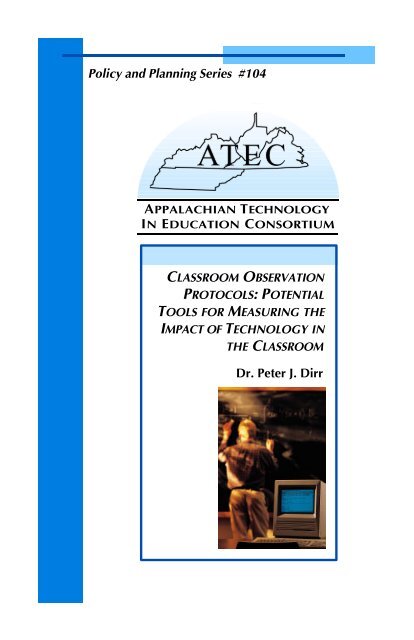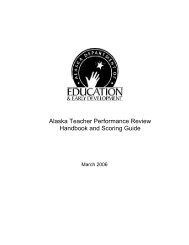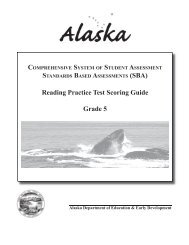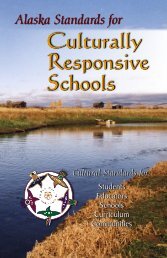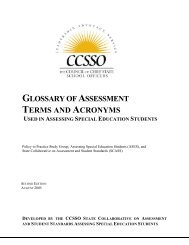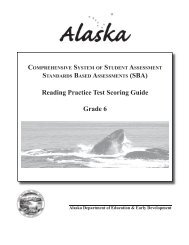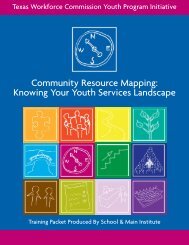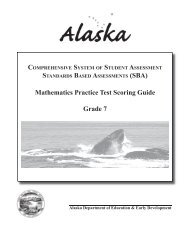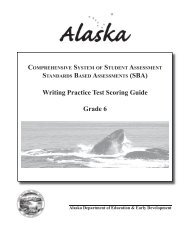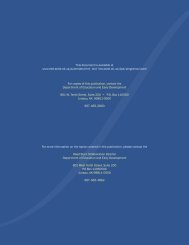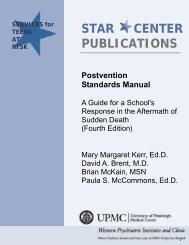Classroom Observation Protocols - Alaska Department of Education ...
Classroom Observation Protocols - Alaska Department of Education ...
Classroom Observation Protocols - Alaska Department of Education ...
You also want an ePaper? Increase the reach of your titles
YUMPU automatically turns print PDFs into web optimized ePapers that Google loves.
Policy and Planning Series #104APPALACHIAN TECHNOLOGYAPPALACHIAN TECHNOLOGIN EDUCATION CONSORTIUMIN CLASSROOM OBSERVATIONPROTOCOLS: POTENTIALTOOLS FOR MEASURING THEIMPACT OF TECHNOLOGY INTHE CLASSROOMDr. Peter J. Dirr
Policy and Planning Series #104 Page 1<strong>Classroom</strong> <strong>Observation</strong> <strong>Protocols</strong>:Potential Tools for Measuring the Impact <strong>of</strong>Technology in the <strong>Classroom</strong>BackgroundFor the past decade or more, there has been a major national effortin the United States to introduce instructional technology toelementary and secondary school classrooms. By some estimates,federal, state, and local governments have invested about$8 billion per year over the last decade, with roughly half thatamount coming from the federal government. The initial goal wasto provide access to instructional technology (computers, educationals<strong>of</strong>tware, and instructional materials) to all students. As aresult <strong>of</strong> this concentrated effort, today virtually all schools andmost classrooms have computers and access to the Internet.In recent years, the focus <strong>of</strong>government investment hasshifted from ensuring accessto educational technology toassessing the impact thattechnology is having onclassroom practices and on… the focus <strong>of</strong> governmentinvestment has shifted fromensuring access toeducational technology toassessing the impact <strong>of</strong> thathow and how much students learn. Some policymakers have begunto question whether the huge investment in technology hasactually made a difference in student academic achievement. Atthe same time, the 2001 No Child Left Behind legislation requiresthat schools prove that the technologies being used in the classroomare contributing to improved teaching and learning. The legislationemphasizes the importance <strong>of</strong> “evidence-based decision-Prepared for the Appalachian Technology in <strong>Education</strong> Consortium with supportfrom The CNA Corporation, Alexandria, VA.
Page 2making” and “scientifically-based” educational practices. Schoolsand school districts are expected to employ practices and technologiesthat have been proven by research to be effective; theyare also expected to use sound research methods to documentthe impact that those practices and the technologies are having onteaching and learning within their classrooms.In this paper, we respond to critical issues raised by the policymakers and recent federal legislation by exploring the potential <strong>of</strong>one class <strong>of</strong> measurement tools, classroom observation protocols,to document the impact that technology is having on how teachersteach and students learn (i.e., classroom practices).<strong>Classroom</strong> observation protocols are not new. In the 1970s, considerableresearch was done on the topic, and many measurementinstruments were developed. Most <strong>of</strong> that research focusedon tracking classroom management and the interactions that tookplace between teacher and students. The results <strong>of</strong> that researchfilled a 15-volume encyclopedia entitled Mirrors on Behavior....the protocols and instrumentsdeveloped in the 1970s requiresignificant revisions … for thedemands and expectations <strong>of</strong>the 21 st century.Today, expectations fordocumentation are morecomplex than they were inthe 1970s. Although thepioneering efforts <strong>of</strong> NedFlanders, Egon Guba,Hilda Taba, and othersprovide a useful foundation, researchers today are finding thateven the best <strong>of</strong> the protocols and instruments developed in the1970s require significant revisions to make them appropriate forthe demands and expectations <strong>of</strong> the 21 st century classroom.The purpose <strong>of</strong> this paper is to identify some <strong>of</strong> the more promisingwork that is being done on classroom observation protocols,especially those protocols that may be helpful in documentingchanges in classroom practices that have resulted from the use <strong>of</strong>instructional technologies. Our work is based largely on a survey<strong>of</strong> the literature on classroom observation that is available on theInternet and on telephone follow-up with researchers in selectedcases. Our intention is to give the leadership <strong>of</strong> the AppalachianTechnology in <strong>Education</strong> Consortium (ATEC) and the otherRegional Technology in <strong>Education</strong> Consortia (RTECs) a sense <strong>of</strong>
Policy and Planning Series #104 Page 3what can be accomplished with classroom observation protocolsand to acquaint them with the names <strong>of</strong> key players in the field.We also assess whether this approach can provide convincingdocumentation <strong>of</strong> the impact <strong>of</strong> the use <strong>of</strong> technology on teachingand learning.<strong>Classroom</strong> observation todayOver the past several years, educators and researchers have developeda number <strong>of</strong> approaches for use in observing and documentingchanges in classroom practices. Their efforts have beenspurred both by the requirements <strong>of</strong> federally funded research initiativesand by the evaluations <strong>of</strong> demonstration programs supportedby the National Science Foundation and the U.S. <strong>Department</strong><strong>of</strong> <strong>Education</strong>. These efforts have taken place at both the elementary/secondaryand higher education levels. We focus on theformer.The importance <strong>of</strong> purposeOne piece <strong>of</strong> advice that surfaces <strong>of</strong>ten in the literature is the importance<strong>of</strong> aligning the classroom observation protocol to the instructionalcontext and the objectives <strong>of</strong> the evaluation. A schooldistrict might take different observation approaches for differentprograms within the district. <strong>Observation</strong> protocols might be helpfultools to:• Evaluate the effectiveness <strong>of</strong> a school program• Assess the performance <strong>of</strong> a teacher or a school• Provide feedback to teachers for pr<strong>of</strong>essional development• Conduct basic research on classroom practices.Types <strong>of</strong> classroom observation protocolsThe world <strong>of</strong> classroom observation protocols is complex andlargely uncoordinated. Researchers have taken a variety <strong>of</strong> approaches.Some have built on the prior work <strong>of</strong> others, but there islittle evidence <strong>of</strong> any attempt to bring cohesion to their efforts.
Page 4Some researchers have developed self-administered, reflectiveapproaches for teachers to use as they introduce classroom reforms;others have developed third-party observation approaches.Some protocols focus on changes in attitudes; many addresschanges in classroom behaviors, especially the interactionsamong teachers and students.<strong>Classroom</strong> observation methods include a wide range <strong>of</strong> approaches:checklists, inventories, timed interval ratings, holisticratings, narrative descriptions, logs, questionnaires, rubrics, matrices,models, conceptual grids, and open-ended questions.An important consideration for researchers, one that is addresseddirectly by some and implicitly by others, is what unit <strong>of</strong> instructionthey will study. This consideration is especially important whenthe protocol involves third-party observers. Will they observe anentire class period? A segment? An entire day? An entire courseor program? Different protocols observe different units <strong>of</strong> instruction.Potential pitfallsConstructing a classroom observation protocol, especially a prot o-col involving third-party observers, presents many challenges andpotential pitfalls, including:• Observer bias. Each observer approaches the classroomwith his or her own experiences and biases. As a result,two observers may focus on different aspects <strong>of</strong> the classroom,and thus record different phenomena for the samelesson• Obtrusiveness. The presence <strong>of</strong> one or more observersintrudes on the normal class environment and can lead tolessons that do not represent the norm.• Contextual variances. Every school environment providesa different context in which the observations take place.This variation can affect the record-keeping behaviors <strong>of</strong>the observers.• Labor costs. <strong>Classroom</strong> observation is labor intensive,<strong>of</strong>ten requiring multiple observers and multiple visits to the
Policy and Planning Series #104 Page 5school. One estimate is that it costs about $20,000 to observethe classes in one school.• Reliability and validity. Unless the observers are givenextensive training, reliability among raters is likely to below, and this will reduce the value <strong>of</strong> the data gathered.Also, unless the ratings are tied to other accepted criteria(such as state or national standards), their validity couldbe questionable.• Links to student performance. Being able to documentclassroom practices is valuable, but the real pay<strong>of</strong>f is inbeing able to link those practices to student academicachievement. Current research efforts have yet to providethis link. (We say more about this problem in the followingsection.)A schemaThe many approaches to classroom observation protocols are difficultto categorize. We can, however, separate protocols that areself-administered from those that require third-party observers.We can also group protocols into (1) those that are primarily quantitative(e.g., checklists and inventories); (2) those that are primarilyqualitative (i.e., they require observers to make judgments andprovide narrative descriptions); and (3) those that have bothquantitative and qualitative elements (e.g., rubrics that require theobserver to convert judgments to ratings for different “levels” <strong>of</strong>behavior). Many <strong>of</strong> the protocols that have taken the quantitativeor combined approaches to third-party classroom observationhave also focused on training observers to a high confidence levelin inter-rater reliability and, therefore, in the protocol itself.In this paper, we do not attempt to discuss all the work that is beingdone on classroom observation protocols. Instead, we identified17 protocols that we believe <strong>of</strong>fer the greatest promise. Table1 lists these protocols and categorizes them according to type.
Page 6Table 1: Exemplary classroom observation protocolsType <strong>of</strong> protocol Self-administered Third-party observerQuantitative (includingchecklists and inventories)Qualitative (includingnarrative descriptions)Combination (includingrubrics)LTPT (NCREL/NCRTEC)(1)ATRL (SCRTEC)(2)UTAP (Utah <strong>Education</strong>Network)(3)TX STaR (TX Ed. Agency)(4)RTOP (ACEPT)(5)CLASSROOM OBSERVATION(Littleton)(6)SOM (U <strong>of</strong> Memphis)(7)TOI (WestEd)(8)TELAR (Penn State)(9)TIC (WestEd)(10)CLASSROOM OBSERVATION(Sun Assoc.)(11)SFO (SRI/MSU)(12)COP (Horizon Research, Inc.)(13)COP (CETP/U. <strong>of</strong> MN)(14)TUOT (WestEd)(15)VCOT (VT Institute. <strong>of</strong> M/S)(16)TTSC (KY Dept. <strong>of</strong> Ed.) (17)All <strong>of</strong> the protocols listed in table 1 meet the following criteria:• They have been carefully researched and developed usingrigorous, systematic, and objective methodology.• They were developed by a university faculty, regional educationlab, or state education agency, or by a commercialresearch organization working with those groups.• They can be applied in a variety <strong>of</strong> settings so as to havenormative data and evidence <strong>of</strong> validity and reliability.• They can be presented in sufficient detail and clarity to allowfor replication and/or the opportunity to build systematicallyon their research.• They may be relevant to the types <strong>of</strong> classroom observationthat are needed to document the impact <strong>of</strong> the use <strong>of</strong>technology in the classroom.Leading classroom observation protocolsIn this section, we describe the 17 protocols, noting the categories<strong>of</strong> classroom activities they include and whether or not they specificallyaddress the question <strong>of</strong> the use <strong>of</strong> technology in the classroom.
Policy and Planning Series #104 Page 71. Instrument: LEARNING WITH TECHNOLOGY PROFILETOOL (LTPT)Developed by: The North Central Regional <strong>Education</strong>al Laboratory/NorthCentral Regional Technology in <strong>Education</strong> ConsortiumNotes: LTPT is a technology-specific, self-administered toolintended primarily for pr<strong>of</strong>essional growth and development. Ituses a 4-point scale to rate indicators <strong>of</strong> engaged learning(including: vision <strong>of</strong> learning, tasks, assessment, instructionalmodel, learning context, grouping, teacher roles, and studentroles) and indicators <strong>of</strong> high-performance technology(including access, operability, organization, engageability,ease <strong>of</strong> use, and functionality). (Available: http://www.ncrtec.org/capacity/pr<strong>of</strong>ile/pr<strong>of</strong>www.htm)2. Instrument: APPLYING TECHNOLOGY TO RESTRUCTUR-ING AND LEARNING (ATRL)Developed by: The South Central Regional Technology in<strong>Education</strong> Consortium (SCRTEC) (K. Victoria Dimock)Notes: This is an extensive study <strong>of</strong> how teachers use computersand technology in constructivist learning environments.It includes self-reporting instrument (the Teaching, Learningand Computing Teacher Survey) as well as a third-party classroomobservation instrument. This study looks at the use <strong>of</strong>technology in the context <strong>of</strong> constructivist learning environments.(A program description, but not the instrument, isavailable at: http://www.sedl.org/work/historical/tap.html)3. Instrument: UTAH TECHNOLOGY AWARENESS PROJECTRUBRICS (UTAP)Developed by: The Utah <strong>Education</strong> NetworkNotes: UTAP is an online, self-administered instrument with atotal focus on technology. It uses a 4-point scale to helpteachers focus on their technology skills in seven areas: basicconcepts, productivity, communication/information, classroominstruction, educational leadership, technology implementation,and technology troubleshooting. (Available: http://wwwj1.uen.org/UTAP, “Log-in As Guest”)
Page 84. Instrument: TEXAS STaR CHARTDeveloped by: The Texas <strong>Education</strong> Agency (based on theCEO Forum/ISTE STaR Chart, also adapted by the Tennessee<strong>Department</strong> <strong>of</strong> <strong>Education</strong>)Notes: The Texas StaR Chart is a self-administered instrumentthat uses a 4-point rubric in four key areas: teaching andlearning, educator preparation and development, administrationand support services, and infrastructure for technology.This is a technology-specific instrument. (Available: http://www.tea.state.tx.us/technology/etac/campus_txstar and http://www.state.tn.us/education/tennesseestarchart.doc )5. Instrument: REFORMED TEACHING OBSERVATION PRO-TOCOL (RTOP)Developed by: The Arizona Collaborative for Excellence in thePreparation <strong>of</strong> Teachers (ACEPT), Arizona State University(Michael Piburn and Daiyo Sawada)Notes: In this protocol, no items are specifically “technology”oriented. RTOP uses a 5-point scale to rate lesson design,content, and classroom culture. It also requires narrativeevaluations from the observer. (Available: http://purcell.phy.nau.edu/AZTEC/rtop/RTOP_full, click on “Using RTOP”)6. Instrument: CLASSROOM OBSERVATIONDeveloped by: Littleton Academy (Colorado)Notes: This protocol modified and simplified the Horizon protocol(see #13 below), reducing it to a single page. This instrumentuses a 4-point scale to rate instructional skills, knowledge<strong>of</strong> content and use <strong>of</strong> materials, focus on students, andclassroom environment. It contains only two items on instructionalmaterials and no items on technology. (Available: http://www.cde.state.co.us/cdechart/guidebook/adm)7. Instrument: SCHOOL OBSERVATION MEASURE (SOM)Developed by: The Center for Research in <strong>Education</strong>al Policy(CREP), University <strong>of</strong> Memphis (S. M. Ross, L. J. Smith, andM. J. Alberg)Notes: SOM is a single-page instrument for assessing thequality <strong>of</strong> an entire school. Rat ers require extensive rater
Policy and Planning Series #104 Page 9training. SOM uses timed observations (ten 15-minute observationsin a single day) and a 5-point rating scale <strong>of</strong> 24 variablesin six categories: instructional orientation, classroom organization,instructional strategies, student activities, technologyuse, and assessment. Two <strong>of</strong> the 24 variables deal withtechnology (use <strong>of</strong> the computer for instructional delivery andtechnology as a learning tool or resource). This protocol has acompanion instrument, Survey <strong>of</strong> Computer Use (SCU), thatrecords information about student use <strong>of</strong> computers over thesame 15-minute intervals. Information includes computeravailability, configurations, student abilities, and student activitieswhile using computers. (A description <strong>of</strong> work, but not instruments,is available at: http://www.people.memphis.edu/~coe_crep/instruments/som.htm)8. Instrument: TECHNOLOGY OBSERVATION INSTRUMENT(TOI)Developed by: WestEd (Mike Timms) (for the Nebraska PT3Catalyst Project)Notes: TOI is part <strong>of</strong> a broader assessment process that includesa pre-observation conference. It uses timed intervals(5 minutes) and a 4-point scale to rate class organization, cognitiveability, classroom interaction, student role, student engagement,technology integration, teacher’s technology use,and students’ technology use. (Available: http://www.necatalyst.org/MTimms.tech.observ.instrmnt%20final1.pdf)9. Instrument: TECHNOLOGY-ENHANCED LESSON ASSESS-MENT RUBRIC (TELAR)Developed by: Penn State University (Kyle Peck)Notes: Designed to capture data by PDA, this application requiresFileMaker V. It uses 3 to 5-point scales to rate appropriateness<strong>of</strong> technology use, student readiness for tech use,student pr<strong>of</strong>iciency with the technologies, teacher pr<strong>of</strong>iciencywith the technologies, student knowledge <strong>of</strong> lesson purpose,on-task behavior, quality <strong>of</strong> student interaction, teacherstudentinteraction, transitions to and from technology, teacheras facilitator, teacher as instructor, meeting diverse studentneeds, higher order thinking, tech problems, and student participation.The entire focus <strong>of</strong> this instrument is on technology
Page 10use. (A description, but not the instrument, is available at:http://www.iu5.org/imts/ptla_web/pdf/KylesReadMe.pdf)10. Instrument: TECHNOLOGY IN THE CLASSROOM TEACHERRUBRIC (TIC)Developed by: WestEd (Harvey Barnett)Notes: Developed as an aid for principals, this instrument focusesentirely on technology. TIC uses a 4-point scale to ratemany variables in five broad areas <strong>of</strong> technology use: productivity,multimedia and communication, research and problemsolving, specific content/subjects, and teaching practice.(Available: http://www.westedrtec.org)11. Instrument: CLASSROOM OBSERVATIONDeveloped by: Sun AssociatesNotes: This single-page instrument uses a combination <strong>of</strong> narrativeand a 3-point scale to rate classroom activity/lesson,student groupings and interactions, and technology and/or instructionalmaterials used. It captures the number <strong>of</strong> computersin the classroom and other notes on the teaching environment.(Available: http://www.sun-associates.com/eval/clsobsv.html)12. Instrument: STEP FACULTY OBSERVATION (SFO)Developed by: SRI/Montana State UniversityNotes: SFO is a largely open-ended instrument that gathersassessment information on instructional setting, teachingmethods employed, instructional goals and objectives, evidence<strong>of</strong> student learning, student engagement, relevance tothe real world, student and teacher questioning, and use <strong>of</strong>technology. This instrument is used mainly in teacher educationprograms at the university level. (Available: http://oerl.sri.com/instruments/te/obsvclassrm/instr76.html)13. Instrument: CLASSROOM OBSERVATION PROTOCOL(COP)Developed by: Horizon Research, Inc. (Refined with severaleducational organizations. See, for example, #6 above and#14 below.)
Policy and Planning Series #104 Page 11Notes: This protocol, which is part <strong>of</strong> a larger assessmentprocess that includes a pre-classroom observation interview,originally focused on math and science. This protocol uses acombination <strong>of</strong> checklists and 5-point scales to describe andrate classroom demographics, lesson description, lesson purpose,instructional materials, classroom instruction, design,implementation, (math/science) content, and classroom culture.It also requires an observer to provide an overall ratingand a “quality capsule.” Few items deal directly with technologyor instructional materials. (Available: http://www.horizonresearch.com/LSC/manual/0102/tab6/cop0102.pdf)14. Instrument: CLASSROOM OBSERVATION PROTOCOL(COP)Developed by: The Collaborative for Excellence in TeacherPreparation (CETP) in conjunction with Horizon Research, Inc.(used by the Texas CETP and also by the University <strong>of</strong> MinnesotaCETP)Notes: This protocol uses timed intervals (5 minutes) and a 5-point scale to rate type <strong>of</strong> instruction, student engagement,cognitive activity, and key indicators. It also requires an observerto provide a “capsule description” <strong>of</strong> the quality <strong>of</strong> thelesson. This protocol was originally designed for math and science,and the only reference to technology is the category“utilizes technology” in the “type <strong>of</strong> instruction.” (Available:http://www.sci.tamucc.edu/txcetp/admin/documents/ClassObProt2002.pdf)15. Instrument: TECHNOLOGY USE: OBSERVATION TOOL(TUOT)Developed by: WestEd (Harvey Barnett and Susan Brooks)Notes: This protocol uses a 5-point scale and narrative(“stages <strong>of</strong> use”) to rate 30 variables in three areas: learningenvironment, student technology use, and lesson implement a-tion. The focus is entirely on technology use. (Available:http://www.westedrtec.org)
Page 1216. Instrument: VERMONT CLASSROOM OBSERVATIONTOOL (VCOT)Developed by: The Vermont Institute for Science, Math, &Technology (VISMT), in conjunction with the <strong>Education</strong> DevelopmentCenter (EDC)/ Northeast and Islands Regional Technologyin <strong>Education</strong> Consortium (NEIRTEC), and VITA-Learn(modeled after work done by the Science and Math ProgramImprovement (SAMPI) at Western Michigan University and HorizonResearch, Inc.)Notes: VCOT is part <strong>of</strong> a broader assessment process thatincludes both pre-observation and post-observation interview.The protocol focuses on four areas: planning and organization<strong>of</strong> a lesson, implementation <strong>of</strong> a lesson, content <strong>of</strong> a lesson,and classroom culture. It imbeds technology criteria withinthose four areas. (This instrument is closely held by the developersand is released only as part <strong>of</strong> the extensive training thatis required. It was not available for review to determine howextensively technology criteria are covered.) (A description <strong>of</strong>the program, but not the instrument, is available at: http://www.vismt.org/programs/leadership/vcot.html)17. Instrument: TEACHER TECHNOLOGY STANDARD CONTIN-UUM (TTSC)Developed by: Kentucky <strong>Department</strong> <strong>of</strong> <strong>Education</strong>, Division <strong>of</strong>School Instructional TechnologyNotes: Although it was not developed strictly as a classroomobservation protocol, this scoring guide (rubric) provides acontinuum <strong>of</strong> technology skills that principals and other administratorscan use to track teachers’ accomplishment <strong>of</strong> theKentucky Teacher Technology Standard. This protocol uses a4-point scale plus commentary in 16 areas <strong>of</strong> technologyknowledge and application. Examples <strong>of</strong> these knowledge areasinclude: knows technology terminations; knows how technologyis used in business and the community; knows how touse the computer and peripherals; uses word processing, databases,e-mail, and presentation s<strong>of</strong>tware to enhance productivityand support learning; creates multimedia presentations;uses assistive technologies for students with special needs;encourages lifelong learning through technology; uses technol-
Policy and Planning Series #104 Page 13ogy for individual, small group, and large group instruction;uses technology to assess student learning; instructs studentsin ethical and legal uses <strong>of</strong> technology. The Kentucky <strong>Department</strong><strong>of</strong> <strong>Education</strong> also makes available a Technology ImpactReview Tool, a set <strong>of</strong> interview questions for all stakeholdersto determine how effectively a district or a school is using technology.(Available: http://www.kde.state.ky.us/oet/customer/evaluation.asp)DiscussionOur purpose was to identify several classroom observation protocolsthat can be used to build a body <strong>of</strong> research-based evidencedocumenting the effect <strong>of</strong> educational technology on classroompractices. This evidence was to be consistent with the intent <strong>of</strong> theNo Child Left Behind legislation.Our review <strong>of</strong> the literature revealed that several dozen observationprotocols have been developed in recent years. A few <strong>of</strong>these protocols are rooted in the extensive work done by researchersin the 1970s. Some are self-administered and might beused by teachers to reflect on their classroom practices, includingthe use <strong>of</strong> technology. Others are third-party observer protocolsthat have been developed to provide an objective assessment <strong>of</strong>the quality <strong>of</strong> classroompractices.Although teachers mayfind the self-administeredinstruments to be valuabletools that may, in fact, lead...self-administered instruments… are not likely to lead toscientifically-based researchevidence that would withstandpr<strong>of</strong>essional scrutiny.to improved classroom practices, they are not particularly useful toour purpose here. They are not likely to lead to scientificallybasedresearch evidence that would withstand pr<strong>of</strong>essional scrutiny.Third-party observer protocols hold the greatest promise for buildinga body <strong>of</strong> research evidence on the effectiveness <strong>of</strong> the use <strong>of</strong>technology in the classroom. They are more likely than selfadministeredinstruments to:
Page 14• Document classroom use <strong>of</strong> technology within a broaderframework <strong>of</strong> classroom practices• Contain a sufficient emphasis on technology to detect itscontribution to teaching and learning• Measure changes in practices over time• Have been carefully tested for validity and reliability• Be administered unobtrusively (i.e., with minimum distractionto students or teacher)• Be administered efficiently (i.e., require a reasonableamount <strong>of</strong> observer time).Some <strong>of</strong> the instruments reviewed in this study are well developedand carefully tested and are effective for documenting the classroomenvironment in general. They include:• The Reformed Teacher <strong>Observation</strong> Protocol from the ArizonaCEPT project• The <strong>Classroom</strong> <strong>Observation</strong> <strong>Protocols</strong> developed by HorizonResearch and CEPT and Sun Associates.These two instruments might be particularly appropriate for use inassessing changes in classroom dynamics when teachers useconstructivist approaches. However, they pay so little attention tothe role <strong>of</strong> technology that they are likely to overlook its contributionto the classroom.Other instruments are more focused on technology but, due to insufficientresearch, may not be ready for widespread use. Theseprotocols include:• The Technology <strong>Observation</strong> Instrument from WestEd• The Technology in the <strong>Classroom</strong> Teacher Rubric fromWestEd• Technology Use: <strong>Observation</strong> Tool from WestEd• The Technology-Enhanced Lesson Assessment Rubricfrom Penn State• The Teacher Technology Standard Continuum from theKentucky <strong>Department</strong> <strong>of</strong> <strong>Education</strong>.
Policy and Planning Series #104 Page 15These instruments deserve further consideration and might be developedinto useful instruments with further testing and validation.Other efforts that deserve careful consideration are quite far alongin the development process:• The School <strong>Observation</strong> Measure (SOM) and the companioninstrument, Survey <strong>of</strong> Computer Use (SCU), the comprehensiveschool approach (i.e., school-wide assessmentplus the Survey <strong>of</strong> Computer Use) developed by the University<strong>of</strong> Memphis/CREP• Applying Technology to Restructuring and Learning(ATRL), the blended approach (i.e., self-administered andthird-party observation) <strong>of</strong> the South Central RegionalTechnology in <strong>Education</strong> Consortium.ConclusionWe have responded to critical issues raised by both federal andstate policy makers about the effectiveness <strong>of</strong> the government’sinvestment in educational technology over the past decade. Ourreview <strong>of</strong> the literature suggests that the development and systematicuse <strong>of</strong> a classroom observation protocol focused on the role <strong>of</strong>technology in the classroom could contribute significantly to buildinga body <strong>of</strong> evidence <strong>of</strong> changes in classroom practices. Nationalsurveys and accountability reporting data have provideduseful insights, but policymakersare still uncertainabout the extent to whichspecific technologies can affectclassroom practices.This report is the first step in… policymakers are stilluncertain about the extent towhich specific technologiescan affect classroom practices.a two-step process designed to measure the impact <strong>of</strong> technologyin education. The second step would involve measuring the specificeffects that technologies are having on student academicachievement and on the conditions that stimulate learning. Suchan ambitious and complex undertaking would require a concentratedeffort and at least five years <strong>of</strong> sustained funding. It wouldrequire serious consideration <strong>of</strong> the type <strong>of</strong> student achievement tobe measured, taking into account the nascent work that is now beingdone to articulate a body <strong>of</strong> 21 st century skills.
Page 16Both the tracking <strong>of</strong> changes in classroom practices and testingthe impact on student academic achievement are consistent withthe expectations <strong>of</strong> the No Child Left Behind legislation for research-basededucational practices. They are also consistent withthe <strong>Education</strong> Sciences Reform Act <strong>of</strong> 2002, which established theInstitute <strong>of</strong> <strong>Education</strong> Sciences, including a new National Centerfor <strong>Education</strong> Research (NCER). One <strong>of</strong> the missions <strong>of</strong> NCER isto “improve student academic achievement through the use <strong>of</strong>educational technology.”New funding opportunities for measuring the impact <strong>of</strong> technologyon teaching and learning are anticipated. Priority will be on fundingfield-initiated research that follows “scientifically-based researchstandards.” In addition to the legislative authorities that,between FY 2002 and FY 2006, will provide states and localschool districts with nearly $5 billion, serious attention is beinggiven to assessing the impact <strong>of</strong> technology on classroom practicesand student academic over this same period.
Policy and Planning Series #104 Page 17ContactsFor more information about the classroom observation protocolsdiscussed in this report, contact the following people:1. LEARNING WITH TECHNOLOGY PROFILE TOOLKristin Ciesemier, DirectorNorth Central Regional Technology in <strong>Education</strong> Consortium1120 East Diehl Road, Suite 200Naperville, IL 60563-1486(630) 649-6500 (P)(630) 649-6700 (F)ncrtec@ncrel.org2. TECHNOLOGY INTEGRATION PHASESK. Victoria DimockDirector, South Central Regional Technology in <strong>Education</strong>ConsortiumSouthwest <strong>Education</strong>al Development Laboratory211 E 7 th StreetAustin, TX 78701(512) 476-6861, x 219 (P)vdimock@sedl.org3. UTAH TECHNOLOGY AWARENESS PROJECT RUBRICSSteve HessUtah <strong>Education</strong> Network101 Wasatch DriveSalt Lake City, UT(801) 581-2310 (P)shess@media.utah.edu
Page 184. TEXAS STaR CHARTAnita Givens, Senior Director<strong>Education</strong>al Technology Advisory CommitteeTexas <strong>Education</strong> Agency<strong>Education</strong>al Technology Division1701 North Congress AvenueAustin, TX 78701(512) 463-9400 (P)(512) 463-9090 (F)etac@tmail.tea.state.tx.us5. TENNESSEE STaR CHARTJerry Bates, Director <strong>of</strong> Applied School Technology710 James Robertson ParkwayAndrew Johnson Tower, 6th FloorNashville, TN 37243-0382(615) 532-6287 (P)(615) 532-7510 (F)Jerry.Bates@state.tn.us6. REFORMED TEACHING OBSERVATION PROTOCOLMike PiburnAZ Collaborative for Excellence in the Preparation <strong>of</strong> Teachers(ACEPT)College <strong>of</strong> <strong>Education</strong>Arizona State UniversityTempe, AZ 85287-0911602-965-0261 (P)602-965-9144 (F)mike.piburn@asu.edu7. CLASSROOM OBSERVATIONLittleton AcademyMary Ann Campbell, Principal1200 West Mineral AvenueLittleton, CO 80120(303) 798-5252 (P)(303) 798-0298 (F)mcampbell@lps.k12.co.us
Policy and Planning Series #104 Page 198. SCHOOL OBSERVATION MEASURESteven M. RossCenter for Research in <strong>Education</strong>al PolicyUniversity <strong>of</strong> Memphis325 Browning HallMemphis, TN 38152-3340(901) 678-2310 (P)(866) 670-6147 (F)smross@memphis.edu9. TECHNOLOGY OBSERVATION INSTRUMENTMike TimmsWestEd730 Harrison StreetSan Francisco, CA 94107-1242(415) 615-3210 (P)(415) 615-3426 (F)mtimms@wested.org10. TECHNOLOGY-ENHANCED LESSON ASSESSMENTRUBRICKyle Peck<strong>Education</strong> <strong>Department</strong>Pennsylvania State University411D Keller BuildingUniversity Park, PA 16802(814) 863-4316 (P)(814) 865-0128 (F)kpeck@psu.edu11. TECHNOLOGY IN THE CLASSROOM TEACHER RUBRICHarvey BarnettWestEd730 Harrison StreetSan Francisco, CA 94107-1242(415) 615-3116 (P)(415) 615-3177 (F)hbarnet@wested.org
Page 2012. CLASSROOM OBSERVATIONJeff SunSun Associates55 Middlesex StreetSuite 216North Chelmsford, MA 01863(978) 251-1600 (P)(978) 251-8700 (F)info@sun-associates.com13. STEP FACULTY OBSERVATIONElisabeth SwansonMontana STEP Project Administrative OfficeMontana State University401 Linfield HallBozeman, MT 59717(406) 994-6768 (P)step@mathfs.math.montana.edu14. CLASSROOM OBSERVATION PROTOCOLIris R. WeissHorizon Research Inc.326 Cloister CourtChapel Hill, NC 27514(919) 489-1725 (P)(919) 493-7589 (F)hri@horizon-research.com15. CLASSROOM OBSERVATION PROTOCOLFrances LawrenzUniversity <strong>of</strong> MinnesotaBurton Hall178 Pillsbury Drive SEMinneapolis, MN 55455(612) 625-2046 (P)lawrenz@umn.edu
Policy and Planning Series #104 Page 2116. TECHNOLOGY USE: OBSERVATION TOOLHarvey BarnettWestEd730 Harrison StreetSan Francisco, CA 94107-1242(415) 615-3116 (P)(415) 615-3177 (F)hbarnett@wested.org17. VERMONT CLASSROOM OBSERVATION TOOLNicole SaginorAssociate Executive DirectorVermont Institute for Science, Math, & Technology7 West StreetMontpelier, VT 05602(802) 828-0068 (P)(802) 828-0076 (F)nsaginor@vermontinstitutes.org18. TEACHER TECHNOLOGY STANDARD CONTINUUMLydia Wells-SledgeDirectorDivision <strong>of</strong> School Instructional TechnologyKentucky <strong>Department</strong> <strong>of</strong> <strong>Education</strong>500 Mero Street, 19th FloorFrankfort, KY 40601(502) 564-7168 (P)(502) 564-6470 (F)lsledge@kde.state.ky.us
Page 22
Policy and Planning Series #104 Page 23AuthorDr. Peter J. Dirr, Public Service Telecommunications CorporationDr. Peter J. Dirr is President <strong>of</strong> the Public Service TelecommunicationsCorporation, a not-for-pr<strong>of</strong>it company that helps schools, universities,libraries, and church groups in the U.S. and abroad usetelecommunications technologies to achieve their missions.Dr. Dirr was also founder and Director <strong>of</strong> the Cable in the <strong>Classroom</strong>Pr<strong>of</strong>essional Development Institute, which, through its computercenters in the Washington, DC area, traveling laptop computerlabs, and virtual workshops on the Internet, trained tens <strong>of</strong>thousands <strong>of</strong> teachers per year in effective use <strong>of</strong> video and Internetresources in their classes.Dr. Dirr has worked for 39 years in the education and telecommunicationsfields. He has taught communications courses at a publicuniversity (State University <strong>of</strong> New York College at Buffalo) forsix years; and at a private university (Manhattanville College) forthree years. In addition, Dr. Dirr worked for two years as Manager<strong>of</strong> Utilization and Interim Director <strong>of</strong> School Services at the largestpublic television station in the United States (WNET, New York).He also worked for three years at the Central Administration <strong>of</strong> theState University <strong>of</strong> New York, where he established a statewideeducational recordings library.The longest span <strong>of</strong> Dr. Dirr's pr<strong>of</strong>essional career (16 years) wasspent at the Corporation for Public Broadcasting (CPB), where hewas a founding staff member and Deputy Director <strong>of</strong> the Annenberg/CPBProject. Dr. Dirr also served as the President <strong>of</strong> theCatholic Telecommunications Network <strong>of</strong> America (CTNA), wherehe committed three years <strong>of</strong> his pr<strong>of</strong>essional life to helping theCatholic Church make effective uses <strong>of</strong> telecommunications technologies.He also served as Executive Director <strong>of</strong> Fairfax CableAccess Corporation, the public access television, radio, and Internetfacilities for Fairfax, Virginia.In the 1970s, Dr. Dirr was involved in research and development ineffective uses <strong>of</strong> media in special education, and he conducted
Page 24pioneering research in mainstreaming handicapped children intoregular classes. He also conducted the first studies <strong>of</strong> the extentto which television, radio, and computers were used in elementaryand secondary schools and postsecondary classes in the U.S.As Deputy Director <strong>of</strong> the Annenberg/CPB Project, Dr. Dirr establisheda reputation as a leader in distance education in the UnitedStates. He developed and managed the Project’s research andevaluation program. He has written extensively in the field andtraveled widely to share his experiences with educators andbroadcasters in other countries. Dr. Dirr served as the first VicePresident (U.S.A.) and Board Member <strong>of</strong> the Consorcio Red deEducacion A Distancia (CREAD) from 1993 to 1995. He alsoserved six years (1992-1998) as a member <strong>of</strong> the Council (Board<strong>of</strong> Directors) <strong>of</strong> the Open University <strong>of</strong> Hong Kong. Dr. Dirr haslectured on distance education and educational uses <strong>of</strong> communicationstechnologies at universities in fourteen countries.Dr. Dirr has served as external evaluator for three federally fundedFIPSE/LAAP projects. He also serves on the editorial board <strong>of</strong> theelectronic Journal <strong>of</strong> Instructional Science and Technology and theInternational Review <strong>of</strong> Research in Open and Distance Learning.Dr. Dirr holds a Ph.D. in Communications in Higher <strong>Education</strong>(New York University), a Masters degree in Guidance and Counseling(Fairfield University), and a Bachelor's degree in Philosophy(St. Joseph's Seminary and College).
A PPALACHIAN TECHNOLOGYAPPALACHIAN TECHNOLOGI N E CONSORTIUMIN EDUCATION The ATEC at CNAC4825 Mark Center DriveAlexandria, VA 22311Policy and Planning Series #104


